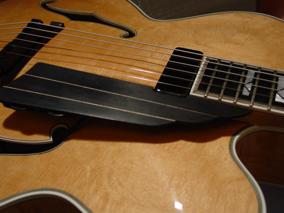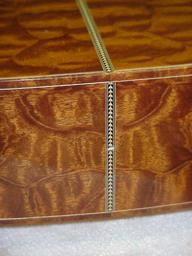Neck Joints (And Some Thoughts)
I have been building acoustic instruments since 1977 and have used just about every neck joint that has been tried in the past. Epoxy butt joints, pinned (Cumpiano/Gurian) mortise and tenon joints, bolted mortise and tenon joints with the fretboard glued to the top and currently a bolted mortise and tenon and bolted fretboard, i.e. a completely mechanical joint. The gist of what I have learned is that all of the joints work and if you find one that you feel comfortable with, that is the one you should use. However, let’s take a look at what is really transpiring in these joints.
Like most things in life all choices have benefits and detriments. The type of neck joint is probably the most important choice in the life of the instrument, although not necessarily for the reasons you might think.
Historically, the classical guitar was the first design. It’s neck was an integral part of the guitar. It was not a separate piece to be joined later. The neck and block were one. Therefore, it was extremely stable. The block as part of the neck, could not rotate. And nylon or gut strings did not exert the forces on the instrument that steel strings do. To understand this exertion you have to look at the forces that operate on the guitar.
Let’s talk about steel strings. A set of light gauge acoustic strings generates about 180-200 pounds of pressure on the instrument. It is constant over the life of the instrument. If you think about that force, it is easy to visualize the fact that the neck is trying to come forward and the fretboard is being forced downward, into the instrument. You have to think about what you are doing in your guitar design that will stabilize that force and, ultimately, delay having to do a neck reset because the neck angle has changed. I have yet to see any steel string instrument that ultimately does not need a neck reset. So, under current designs (Martin, Gibson dovetails and other glued necks), the neck reset is delayed for 10-20 years but will ultimately need to be re-adjusted (or thrown away).
Let’s analyze the forces that cause this situation and how they relate to the neck joint. The parts of the guitar involved include the 1) neck block itself, 2) the neck joint, 3) fretboard, and 4) the upper transverse brace (and, in Martin’s case the so-called popsicle brace).
I have found that a neck block that is less than 2 3/4” wide is asking for instability. Imagine the block. Before the dovetail or tenon is cut into the guitar the sides have a full 2 3/4” of glue surface. Once the tenon (I’ll use 3/4” tenon) is cut into the guitar that leaves a 1” or less glue surface on either side of the block. Assume your block is 1 5/8” thick. That means that, initially, there is a 2 3/4” x 1 5/8” portion of the block that is glued to the top and back and this effectively stabilizes the block from rotating inward. Whether a mortise or a dovetail mortise is cut into the block this takes away from the glued surface of the top to the block which provides this stability.
So, strictly in terms of stability/instability of block rotation, a butt joint would provide the most stable solution. The downside to this approach would be that the joint is totally permanent and cannot be adjusted in the future. BUT we know that all necks need to be reset at some point in the guitar’s useful life. So, this is not a practical solution over the long term.
As a result, most builders have gravitated to either the Martin style dovetail or some variation of a mortise and tenon joint. Let’s analyze both.
The dovetail is a woodworking joint that sustains itself; the glue just holds its’ position. It is doubtful that it would ever free itself from the guitar. The downside is that it is more difficult to get right in the initial build and, when it needs to be reset, it is a major repair job to do it in a way that is totally invisible. If you can tolerate getting it right in the first place and then ultimately, have to repair (reset), it is a great solution.
Now let’s look at the conventional mortise and tenon and bolts. This too, is a joint that works very well. Usually it is two bolts, one at the top of the joint and the other at least greater than halfway along the bottom portion of the tenon. No glue on the mortise and tenon. Done properly, this is an extremely stable joint on par with the dovetail. However, its’ only advantage over the dovetail is that it is easier to adjust in the build process.
As with the dovetail joint the fretboard is glued to the top. The glued fretboard, in itself, acts as a brace linking the transverse brace to the neck providing great stability. However, gluing the fretboard in place complicates the future neck resets of either the dovetail or mortise and tenon.
In the past fifteen years or so, industrious builders have figured out ways to attach the neck to the body in a purely mechanical fashion, i.e. bolts on the neck and bolt(s) on the fretboard. However, these methods required a rethinking of the basic structure of the guitar/neck mechanism.
If the fretboard is not glued down to act as a bridge to the transverse brace then the top itself must thoroughly bridge the gap to link the transverse brace and spread the torsional force to the sides of the guitar. Most instruments that I have examined with the “double mortise and tenon” joint beef up the transverse brace and remove very little material from the ends of the brace so that the forces can be dissipated to the sides. This seems to work very well. However we don’t have 100 years of history to give us an ultimate answer.
We do know, however that this joint can be disassembled in a matter of minutes, the neck angle re-adjusted, and the guitar fixed completely in less than a half an hour without any damage to the finish or anything else on the instrument. This is a huge advantage to builders who have to deal with warranty issues.
So, in the end, any of these joints work well. The reason that there has been experimentation in this area of guitar building is the builder’s quest to find a joint that is easily adjusted, not only in the build process, but down the instrument’s life. You should choose the one that makes the most sense to your woodworking goals.

![]()
![]()


